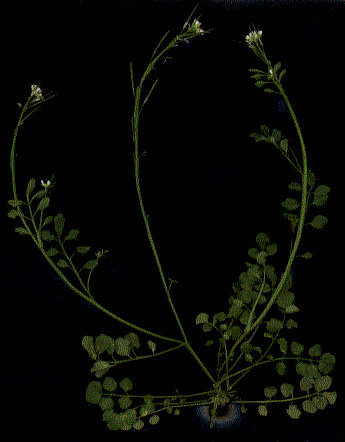| Plant of the Month: March 2002 |
| Bittercress |
| In February 1987 I first wrote about this weed. At the time, like everyone else in our area, I misidentified it, writing: "Unlike about 90% of our weed species, this is native here; it ranges from east Siberia through Alaska and British Columbia to north California." Actually, the ubiquitous weed naturalized in Seattle and other Pacific Northwest cities is the Eurasian Cardamine hirsuta L. ("Hairy Bittercress") -- superficially almost identical to our apparently very rare native Cardamine oligosperma Nutt. ("Little Western Bittercress"). |
| The genus Cardamine is in the mustard family, known in science as CRUCIFERÆ or BRASSICACEÆ. The "book" English name is bittercress. Unfortunately, to describe its flavor as bitter is wrong. A related English weed was named over two hundred years ago by Linnaeus Cardamine amara, the specific name meaning in Latin bitter. No common folk ever called that weed, or its close kin, bitter. But bookwriters heedlessly transferred the inaccurate name to all sorts of Cardamine species. Local names such as "Spitweed" or "Shotweed" or "Poppits" or "That Little Green Thing" go unacknowledged in books. Whatever we call it, we agree it is very abundant, and easy to weed-up, but nearly impossible to get rid of totally. It is also a delicious, nutritious wild edible, reminiscent in flavor to watercress. Try it. |
| Specimens can be found any time of year, but are most abundant and conspicuous in spring. It grows lushly and is inured to cold. It thrives and proliferates on the worst sites, tolerating wet muck, hard gray clay, mossy rockeries, light forest-duff, and garden beds -- in both sunshine and shade. It can assume abject, depauperate stature, sending up paltry, pitiful little flowerstems. In the most favorable circumstances a height of 17 inches may be achieved. |
| Bittercress is a petty annual herb colored rich green or tinged purplish. Its leaves are pinnately compound, of usually 7 rounded leaflets. The flowers, minute white affairs, give rise to slender seedpods nearly an inch long. As these seedpods ripen, the slightest disturbance causes them to explosively spit out their cargo. Does the gardener live whose face has never had any such seeds spat square into it? Dry summer weather withers the weed, turning it straw-colored. It doesn't care -- its seeds are all over by then. |
Thus, this little weed is spartan and stoic regarding its requirements; has an ultra-sensitive impatient hang-up or obsession about reproduction; labors under a calumnious misnomer; and is held in such general contempt as are but few of its Cardamine cousins. But taste its fresh, tender growth and you will never see it in the same way. It is a delicious nibble. Other Cardamine species also are edible and taste similar. In Seattle we find the following wild: Wavy Bittercress (C. flexuosa), Cuckoo Flower (C. pratensis), Pennsylvania Bittercress (C. pensylvanica). At one time two other native species also grew here, but are extirpated. Various non-native species are cultivated as ornamentals.
Back |

scan by ALJ |
|
|

